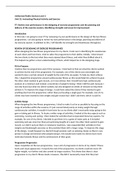Uniformed Public Services Level 3
Unit 32: Instructing Physical Activity and Exercise
P7: Review own performance in the designing of exercise programmes and the planning and
delivery of the exercise session, identifying strengths and areas for improvement.
Introduction
In this task, I am going to cover P7 by reviewing my own performance in the design of the two fitness
programmes. I am also going to review my own performance in the design, planning and delivery of
my exercise session. In addition to this, I will identify my strengths and weaknesses throughout.
REVIEW OF DESIGNING OF EXERCISE PROGRAMMES
When designing the two fitness programmes for my clients, I took care in identifying the weaknesses
of each client and from there, tried to tailor the programme to their ability. Initially, I interviewed
the two clients to find out what they most enjoyed about fitness, and what they disliked about it.
This helped me gather a clear understanding of them, which helped me in the designing stage.
Fit for Purpose
I believe that my programmes were fit for purpose, I tried hard to find out what the clients wanted
to achieve by the end of the programme. For example, one of the clients was overweight and
wanted to lose a certain amount of weight by the end of the six-weeks. To help my client achieve
this, I shaped the programme around cardiovascular fitness as this would help him achieve his goal.
My other client wanted to gain muscle, so it was obvious that I should have kept cardiovascular
sessions at a minimum and instead, concentrate of weight training. I think I did this well, because I
not only found out what my clients wanted, but also designed six-weeks of sessions to help them
achieve it. To improve this stage of design, I could have asked the clients if they wanted to gain
anything else from the programme, rather than just locating a single goal. For example, one of my
clients may have wanted to lose weight and gain muscle but I didn’t ask them, which I could’ve.
Activity Range
When designing the two fitness programmes, I tried to make it as fun as possible by focusing on the
range of activities within the sessions; if I just concentrated purely on losing weight through
cardiovascular activities, it wouldn’t have been fun as my clients didn’t necessarily enjoy going to the
gym or taking part in fitness. To locate a wider range of activities, I looked at the key aspects such as
swimming, running and cycling; I then looked for activities that incorporated these key aspects. For
example, for one of my clients, I decided to put them in to a game of water polo as it included
swimming and was more fun than just swimming lengths of a pool. My other client wanted to gain
muscle, so I didn’t just put them on resistance machines, I also expanded their activities to free
weights and bodyweight exercises as this provided them with a larger range. To improve this stage
of the design, I could haveput my clients through sessions such as spinning classes as there is one
person in charge and several other people doing it, this would have made my clients much more
motivated towards fitness and the achievement of their goals.
Programme Progression
Upon completion of the two programmes, I saw a lot of progression in terms of my clients’ fitness
levels and visual appearance. Towards the end of the programme, my clients could do more; lift
higher weight, run further and also commit to longer sessions. This shows that there is clear
progression in my client’s fitness levels. However, this didn’t necessarily mean that they had





